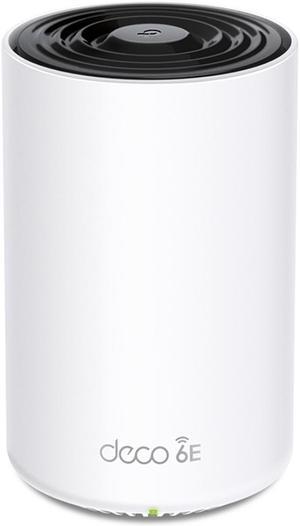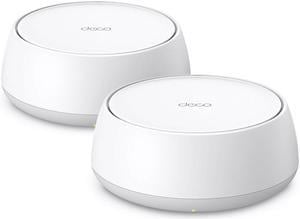
OUT OF STOCK
- Type: Mesh WiFi System
- Router & Satellite Counts: 1-Pack (1 Router)
- Covered Area: 1-3 Bedroom Houses
- Wi-Fi Standards: Wi-Fi 6E
- Model #: Deco XE75 Pro(1-pack)
- S$263.13 –
- More options from S$263.13 - S$280.53
- S$47.69 Shipping

OUT OF STOCK
- Covered Area: 4,500 sq. ft.
- WAN Ports: Dynamic IP Static IP PPPoE PPTP L2TP
- Wi-Fi Standards: Wi-Fi 7 IEEE 802.11be/ax/ac/n/a 5 GHz IEEE 802.11be/ax/n/b/g 2.4 GHz
- Security: Real-Time IoT Protection Malicious Site Blocker Intrusion Prevention System DDoS Attack Prevention Home Network Scanner
- Model #: Deco BE25(2-Pack)
- S$331.55 –
- Free Shipping
- Home WiFi
- Fast WiFi?
- Extending WiFi Range
- Brands
A new generation of smart WiFi systems automate and optimize home networking, especially in larger spaces with heavy network traffic. Learn if a smart WiFi router and wireless access points make sense for your bandwidth and budget needs, and find out whether new technology like 801.11ac, MU-MIMO, and beamforming are worth it for your home network.
The ISP connection and modem is the brawn
A fast connection starts with the Internet Service Provider (ISP) line to your home. Know that a home network is never faster than the Cable, DSL, or Fiber connection you get from the ISP. Cable and DSL connections range from 25-50 MB/s rates for consumer connections. If you’re lucky enough to live where fiber is available, you may see rates upwards of 300 MB/s.
A modem converts the ISP signal into to digital bandwidth that other network components use to communicate with each other. Usually consumers rent modems from the ISP at a monthly rate, and you can save money about a year after you buy a modem on the consumer market. ISPs publish lists of compatible modems on their websites--use this as a reference to buy a modem for yourself.
The WiFi router is the brain
From the modem, the router distributes the signal to different endpoints on the home network. Today, all routers are WiFi routers that combine Ethernet connectivity (LAN ports) with a built in wireless access point (WAP). The wireless access point broadcasts a wireless network connection to endpoints on the home network.
New routers using the latest IEEE 802.11ac specifications, MU-MIMO antenna technology, that are capable of focusing in a wireless signal on specific endpoints--a process called beamforming--make a home network more dynamic and flexible when there are a lot of endpoints accessing the network in a larger home or office.
2.4 GHz and 5 Ghz are the bands
Dual band WiFi routers send out signals across two separate bands (also called spectrums) of radio frequency: one is centered at 2.4 GHz and the other at 5 GHz.
The 2.4 GHz band is used by all sorts of remote control devices--garage door openers, TV remotes, baby monitors, police scanners, et cetera--so it tends to be noisier. Network congestion impedes the connection and access feels slow. Newer laptops, phones, and tablets are built to communicate at the 5 Ghz wavelength to avoid the congestion.
The physically larger 5 GHz wavelength yields a faster data transfer, but the 2.4 GHz spectrum does have advantages. The 5 GHz band has a shorter range in open space, and has a harder time penetrating solid walls, metal doors, water pipes, heaters and aquariums—and is more susceptible to interference from electronic appliances.
Premium-quality Tri-band WiFi routers give users a 2.4 GHz channel and two 5 Ghz channels. A tri-band is advantageous when there are upwards of 15-20 endpoints vying for bandwidth on the WLAN and performance is critical for the end users. The extra 5 Ghz band is like adding a lane on a congested freeway helping everything move along.
